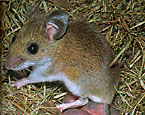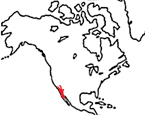|
California Deermouse
(Peromyscus californicus) |
||||
|
|
Physical
characteristics and distribution
|
|
Head and body length of Peromyscus species range from
70-170 mm and tail lengths are 40-205 mm. There are 2 subgenera
and 55 species. P. californicus
has soft dense fur and large ears which are covered with fine
hairs. The tail is about one third the length of the total length
of this mouse, and is also covered with fine hairs. Females
have four or six mammae. Studies have shown that a paired male and female P. californicus will live together cooperatively raising offspring. males are highly aggressive toward one another. Estrous cycles last an average of 7 days, gestation periods range from 21-27 days and averaging 23.4 days in non-lactating females. Lactating females can have gestation periods of up to 40 days.. Litter sizes vary by region, with those in the northern areas being larger. Overall litter sizes for Peromyscus genus is 3.4 offspring weighing 2.2 grams. Most young are weaned at 3-4 weeks and stay with the mother for another month. P. californicus occurs from C and S California, USA, excluding the San Joaquin Valley, to NW Baja California Norte, Mexico. |
|
Description
of the brain
|
|
Animal
source and preparation
|
|
All
specimens collected followed the same preparation
and histological procedure.
|
Other Related Resources (websites and publications)
List of Specimens | Explore Collections | Brain Sections | Brain Evolution | Brain Development | Brain Circuitry | Brain Functions | Location and Use | Related Web Sites | Contact Us | Search MSU Database | Personnel | Home



